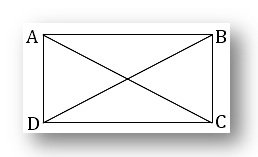Subscribe to our ▶️ YouTube channel 🔴 for the latest videos, updates, and tips.
4th Grade Math Practice 3
Test on 4th Grade Math Practice 3 covers various questions on different topics. The questions are mainly based on roman numbers, counting numbers, addition and subtraction word problems, estimating products and quotient and geometric figures.
Test Yourself
1. (a) Write today's date and month in Roman Numerals.
(b) Write the answer in Roman Numerals.
(i) IX + X = ______
(ii) XXVIII ÷ IV = ______
2. (a) Counting by hundreds write the next two numbers of:
(i) 9937; _____ ; _____.
(ii) 10912; _____ ; _____.
(b) Counting by thousands write the next two numbers of:
(i) 29,989; _____ ; _____ .
(ii) 10209; _____ ; _____ .
3. 12 buses took the children to school. Each bus carried 96 children.
How many children were taken to school?
Choose the correct operation to find the answers.
(a) 96 + 12;
(b) 96 - 12;
(c) 96 × 12;
(d) 96 ÷ 12
4. Tammy spent $54 on a set of pencils. If each pencil costs $6, how many pencils did she buy?
Choose the correct operation to find the answer.
(a) 54 - 6;
(b) 54 + 6;
(c) 54 × 6;
(d) 54 ÷ 6.
5. Find the product and estimate to the nearest thousand.
327 × 284
6. (a) Find the product of:
(i) 2974 × 100
(ii) 1086 × 1000
(b) Find the quotient of:
(i) 6490 ÷ 10
(ii) 7098 ÷ 100
7. Find the quotient and verify it.
2826 ÷ 14
8. Find the estimated and actual quotient of:
2396 ÷ 12
9. (a) Write a division sentence for each multiplication:
(i) 9 × 3 = 27
(ii) 4 × 8 = 32
(b) Copy and complete the number sentence:
(i) ____ × 33 = 19 × ____
(ii) 24 + 24 + 24 = 24 × ____
10. (a) Name the line segments in this figure:

(b) How many triangles are there in this figure?
Answers for 4th Grade Math Practice 3 are given below to check the exact answers of the above questions.
Answers:
1. (b) (i) 19
(ii) 20
2. (a) (i) 10037; 10137
(ii) 11102; 11112
(b) (i) 30989; 31989
(ii) 11209; 12209
3. 96 × 12
4. 54 ÷ 6
5. 92868; 93000
6. (a) (i) 297400
(ii) 1086000
(b) (i) 649
(ii) Q – 70; R – 98
7. Q – 201; R – 12
8. Q – 199; R – 8
9. (a) (i) 27 ÷ 9 = 3; 27 ÷ 3 = 9
(ii) 32 ÷ 4 = 8; 32 ÷ 8 = 4
(b) (i) 19 × 33 = 19 × 33
(ii) 24 + 24 + 24 = 24 × 3
10. (a) AB; BC; AD; AC; BD
(b) 8
From 4th Grade Math Practice 3 to HOME APGE
Didn't find what you were looking for? Or want to know more information about Math Only Math. Use this Google Search to find what you need.


New! Comments
Have your say about what you just read! Leave me a comment in the box below. Ask a Question or Answer a Question.